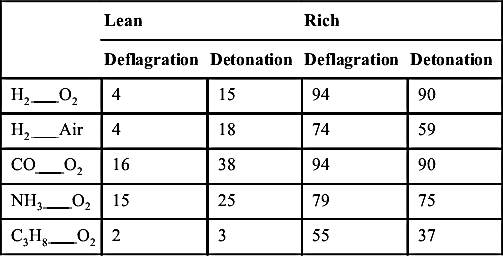5.7. Detonations in Nongaseous Media
Detonations can be generated in solid propellants and solid and liquid explosives. Such propagation through these condensed phase media make up another important aspect of the overall subject of detonation theory. The general Hugoniot relations developed are applicable, but obtaining appropriate solutions is difficult due to the lack of good equations of state necessary for the very high (105 atm) pressures generated. For details on this subject, the reader is referred to any [30] of a number of books.
Detonations will also propagate through liquid fuel droplet dispersions (sprays) in air and through solid–gas mixtures such as dust dispersions. Volatility of the liquid fuel plays an important role in characterizing the detonation developed. For low-volatility fuels, fracture and vaporization of the fuel droplets become important in the propagation mechanism, and it is not surprising that the velocities obtained are lower than the theoretical maximum. Recent reviews of this subject can be found in Refs [31] and [32]. Dust explosions and subsequent detonation generally occur when the dust particle size becomes sufficiently small for the heterogeneous surface reactions to occur rapidly enough that the energy release rates will nearly support C−J conditions. The mechanism of propagation of this type of detonation is not well understood. Some reported results of detonations in dust dispersions can be found in Refs [33] and [34].
..................Content has been hidden....................
You can't read the all page of ebook, please click here login for view all page.

